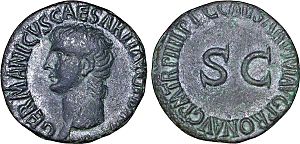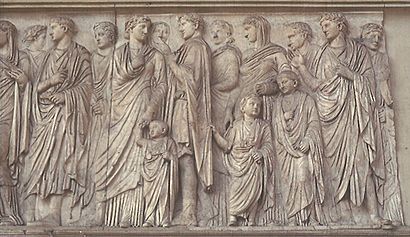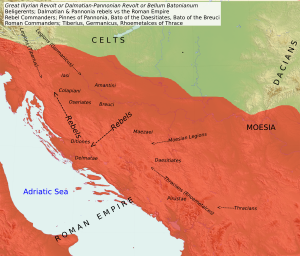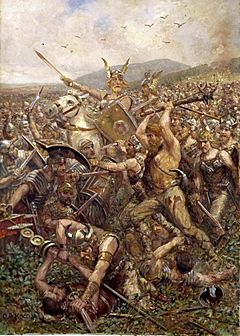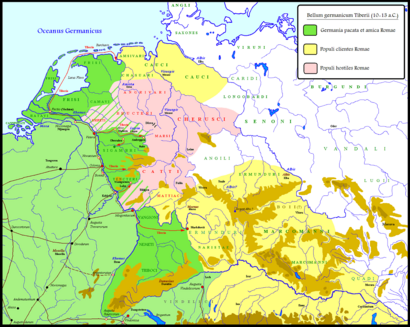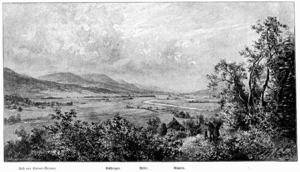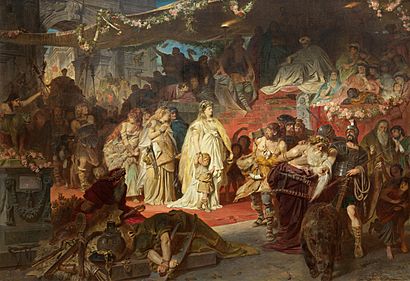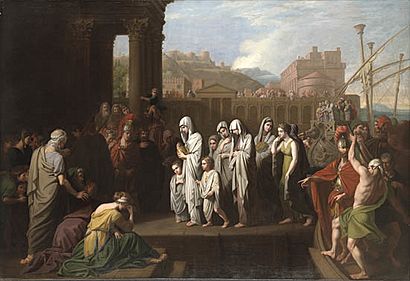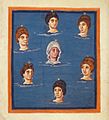Germanicus facts for kids
Quick facts for kids Germanicus |
|||||
|---|---|---|---|---|---|
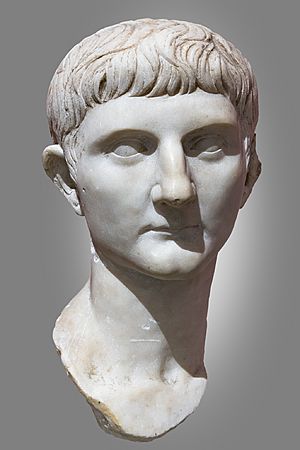
Bust of Germanicus
(Musée Saint-Raymond) |
|||||
| Born | 24 May 15 BC Rome, Italy |
||||
| Died | 10 October AD 19 (aged 33) Antioch, Roman Syria (modern-day Antakya, Hatay, Turkey) |
||||
| Burial | Mausoleum of Augustus | ||||
| Spouse | Agrippina the Elder | ||||
| Issue among others |
|
||||
|
|||||
| Dynasty | Julio-Claudian | ||||
| Father |
|
||||
| Mother | Antonia the Younger | ||||
| Military career | |||||
| Battles/wars | Great Illyrian Revolt Battle of Idistaviso Battle of the Angrivarian Wall |
||||
Germanicus Julius Caesar (born May 24, 15 BC – died October 10, AD 19) was a famous Roman general and politician. He is best known for his military campaigns in Germania.
Germanicus was the son of Nero Claudius Drusus and Antonia the Younger. He belonged to the powerful gens Claudia family. The special name Germanicus was added to his full name in 9 BC. This was done to honor his father's victories in Germania after his father had died.
In AD 4, Germanicus was adopted by his uncle Tiberius. Tiberius later became the Roman emperor after Augustus. Because of this adoption, Germanicus also became part of the gens Julia, another very important family. He was already related to them through his mother. His connection to the Julii Caesares became even stronger when he married Agrippina the Elder, who was a granddaughter of Emperor Augustus. Germanicus was also the father of Caligula, who would become emperor. He was the grandfather of Nero, another future emperor, and the older brother of Claudius, who also became emperor.
During Augustus's rule, Germanicus quickly rose through the political ranks. He became a quaestor in AD 7, which was five years earlier than the usual age. He served in this role until AD 11. In AD 12, he was elected consul for the first time. The next year, he was made a proconsul in Germania Inferior, Germania Superior, and all of Gaul. From there, he commanded eight legions, which was about one-third of the entire Roman army at that time. He led these legions against the Germanic tribes in campaigns from AD 14 to 16. He helped Rome get revenge for its defeat in the Battle of the Teutoburg Forest. He also got back two of the three legionary eagles that had been lost in that battle. In AD 17, he returned to Rome and was given a grand triumph. After this, he left to reorganize provinces in Asia Minor. He added the regions of Cappadocia and Commagene in AD 18.
While in the eastern provinces, Germanicus had disagreements with Gnaeus Calpurnius Piso, the governor of Syria. During their conflict, Germanicus became ill in Antioch and died on October 10, AD 19. His death was sudden and caused much sadness, with some people believing he was poisoned, though this was never proven. Germanicus was a very popular general and was seen as an ideal Roman even after his death. Many Romans compared him to Alexander the Great because he died young, had a good character, was handsome, and was famous for his military skills.
Contents
Germanicus's Name
We don't know Germanicus's first personal name (called a praenomen). He was likely named Nero Claudius Drusus after his father, or possibly Tiberius Claudius Nero after his uncle. He took the special name "Germanicus" in 9 BC. This name was given to his father after his death to honor his victories in Germania. At this point, Germanicus became the official head of his family.
In AD 4, Germanicus was adopted by Tiberius, who was his uncle and also the adopted grandson of Julius Caesar. Because of this adoption, Germanicus left the Gens Claudia family and joined the Gens Julia. Following Roman traditions, he took the name "Julius Caesar" but kept his special name, becoming Germanicus Julius Caesar.
Family and Early Life
Germanicus was born in Rome on May 24, 15 BC. His parents were Nero Claudius Drusus and Antonia Minor. He had two younger siblings: a sister named Livilla and a brother named Claudius. His grandmother on his father's side was Livia, who later became the widow of Emperor Augustus. His grandparents on his mother's side were Mark Antony and Augustus's sister, Octavia Minor.
Germanicus was a very important person in the Julio-Claudian dynasty, the ruling family of the early Roman Empire. He was the great-nephew of Emperor Augustus and the nephew of the second emperor, Tiberius. Later, Germanicus's son Gaius became the third emperor. His brother Claudius became the fourth emperor, and his grandson Nero became the fifth.
When Augustus's chosen heir, Gaius Caesar, died in AD 4, Augustus thought about making Germanicus his next heir. However, Livia convinced Augustus to choose Tiberius instead. As part of the plan for who would rule next, Augustus adopted Tiberius in AD 4. But first, Augustus made Tiberius adopt Germanicus. This meant Germanicus was next in line to the throne after Tiberius. Germanicus married Augustus's granddaughter, Agrippina the Elder, probably the next year. This marriage further strengthened his ties to the imperial family.
Germanicus and Agrippina had nine children: Nero Julius Caesar; Drusus Caesar; Tiberius Julius Caesar; an unnamed child; Gaius the Elder; Gaius the Younger (who became Emperor "Caligula"); Agrippina the Younger (who became empress); Julia Drusilla; and Julia Livilla. Only six of their children lived to adulthood.
Military Career
Fighting in the Great Illyrian Revolt
Germanicus became a quaestor in AD 7, which was four years earlier than the usual age. That same year, he was sent to Illyricum to help Tiberius put down a rebellion by the Pannonians and Dalmatians. Germanicus brought an army of new soldiers, including former slaves, to help Tiberius at his base in Illyricum.
The rebels had hidden in mountain forts and were attacking Roman forces from there. The Romans divided their army into smaller groups to cover more ground. They also offered peace to tribes that would stop fighting and burned crops to starve the enemy. During this time, Germanicus's troops fought and defeated the Mazaei tribe.
The rebellion in Pannonia ended in AD 8. The Romans then pushed into Dalmatia in AD 9. Germanicus's forces captured several cities. They also helped Tiberius capture the rebel leader Bato. Germanicus then led a mission to punish the surrounding areas, forcing many towns to surrender.
Between Major Campaigns
After his successful military start, Germanicus returned to Rome in late AD 9 to announce his victory. He received special honors, including the right to be a candidate for consul earlier than usual. He was very popular because he often defended people in court.
In AD 9, three Roman legions were destroyed by German tribes led by Arminius in the Battle of the Teutoburg Forest. In AD 11, Germanicus was sent with Tiberius to defend the empire against the Germans. They crossed the Rhine River and explored enemy lands. Their campaigns, along with an alliance with another German group, stopped the German tribes from invading Gaul and Italy.
In AD 12, Germanicus returned to Rome and was appointed consul, even though he had not held all the usual political offices before. He continued to defend people in court, which made him even more popular. He also organized games where 200 lions were released in the Circus Maximus.
In AD 12, Tiberius held a triumph for his victory over the Pannonians and Dalmatians. Germanicus marched alongside him, receiving special recognition for his own achievements.
Commander in Germania
In AD 13, Emperor Augustus made Germanicus the commander of the Roman forces along the Rhine River. This army had eight legions, which was about one-third of Rome's entire military. The next year, Augustus died. Tiberius became emperor, and Germanicus was given special command over the Rhine armies.
At this time, the legions in Germany and Illyricum rebelled. The soldiers were not happy about their pay and wanted to serve for fewer years. Germanicus went to the troops in Germany. They tried to declare him emperor because he was so popular, but he stayed loyal to Tiberius. Germanicus negotiated a deal: soldiers would get a full discharge after 20 years, or lighter duties after 16 years. They also received double the bonus money promised by Augustus.
First Campaign Against German Tribes
To keep his promise, Germanicus paid the soldiers from his own money. All eight legions received money, even those who hadn't demanded it. Both armies returned to order. To ensure their loyalty, Germanicus led them on a raid against the Marsi tribe. He destroyed their villages and took their supplies. On their way back, they successfully fought through other tribes.
In Rome, Tiberius praised Germanicus's actions. The Senate voted to give Germanicus a triumph, a special parade to celebrate military victories.
Second Campaign Against German Tribes

For the next two years, Germanicus led his legions across the Rhine to fight Arminius and his allies. Historians say these campaigns were to get revenge for the Roman defeat at Teutoburg Forest, not to gain new land.
In early AD 15, Germanicus attacked the Chatti tribe. He captured their capital and took their supplies. He then returned to the Rhine. Around this time, he rescued Segestes, a German leader held prisoner by Arminius. Germanicus also captured Arminius's pregnant wife, Thusnelda. He returned victorious and was given the title of Imperator (victorious general) by Tiberius.
Arminius gathered his own tribe, the Cherusci, and other tribes to fight back. Germanicus launched a combined land and river attack. His forces recovered a lost Roman eagle from the 19th Legion after defeating the Bructeri tribe.
Germanicus's legions met up and destroyed the countryside between the Ems and Lippe rivers. They reached the Teutoburg Forest, where the Romans had suffered a terrible defeat years earlier. Germanicus and his men began burying the remains of the Roman soldiers left there. He then continued his war against the Germans. Arminius's troops attacked the Romans in a swampy area. The fighting lasted two days, with no clear winner. Germanicus's forces then returned to the Rhine.
Third Campaign Against German Tribes
For his next campaign in AD 16, Germanicus built a large fleet of ships. He led eight legions and other troops across the Rhine, up the Ems and Weser rivers. His forces met Arminius's army on the plains of Idistaviso, near the Weser River. This battle is known as the Battle of the Weser River.
Arminius and his uncle were both hurt but escaped capture. The Roman soldiers honored Tiberius as Imperator and built a trophy with the names of the defeated tribes.
Seeing the Roman trophy angered the Germans, who then attacked the Roman positions at the Angrivarian Wall. This started a second battle. The Romans were ready and defeated the Germans again. Germanicus said he wanted no prisoners, believing the war would only end with the destruction of the German tribes. The Romans then built a monument to their victory.
Germanicus sent some troops back to the Rhine by land and by boat. A storm struck the boats as they reached the North Sea, sinking many and killing many men and horses.
Germanicus then sent a general to attack the Chatti tribe and destroy their land. Germanicus himself invaded the Marsi tribe for the third time. He forced their defeated leader to reveal the location of another of the three legion's eagles lost in AD 9. Germanicus immediately sent troops to get it back.
Germanicus's successes in Germany made him very popular with the soldiers and the Roman people. Tiberius noticed this and called Germanicus back to Rome. He told Germanicus he would receive a triumph and be given a new command.
Campaign Results
Conquering all of Germania Magna was thought to be too difficult and not very profitable. Rome saw Germany as a wild land with little wealth. However, Germanicus's campaigns greatly helped Rome recover from the shock of the Varus disaster and restored Roman pride. He recovered two of the three lost eagles and fought Arminius, the leader who had destroyed three Roman legions.
Germanicus had led his troops across the Rhine without asking Tiberius first. This went against Augustus's advice to keep the Rhine as the empire's border. This independent action might have made Tiberius doubt Germanicus's motives. This political mistake gave Tiberius a reason to recall his nephew. Some historians believe Tiberius was jealous of Germanicus's popularity and glory.
Return to Rome and Command in Asia
In early AD 17, Germanicus returned to Rome. On May 26, he celebrated a grand triumph. He had captured some important prisoners, including Arminius's wife, Thusnelda, and her young son. The parade showed scenes of mountains, rivers, and battles, and the war was considered over.
Tiberius gave money to the people of Rome in Germanicus's name. Germanicus was also scheduled to be consul again the next year with the emperor. In AD 18, Germanicus was given command of the eastern part of the empire. This was a similar role that important figures like Agrippa and Tiberius had received when they were considered future emperors.
Command in Asia Minor and Egypt
After his triumph, Germanicus was sent to Asia to reorganize the provinces and kingdoms there. These areas were in disorder, and a high-ranking official was needed to fix things. Germanicus was given special command over other governors and commanders in the area. However, Tiberius had replaced the governor of Syria with Gnaeus Calpurnius Piso. Piso was supposed to help Germanicus but turned out to be hostile.
Germanicus had a busy year in AD 17. He restored a temple and may have won a chariot race at the Olympic Games. He left Rome after his triumph, before the end of AD 17. He sailed to Greece and then to Asia Minor. There, he visited Troy and an oracle. Piso also traveled to the East and met Germanicus in Rhodes. From there, Piso went to Syria and began replacing officers with men loyal to himself.
Next, Germanicus traveled to Armenia. He installed a new king, Artaxias, replacing a king whom Augustus had removed. The king of Cappadocia also died, so Germanicus made Cappadocia a Roman province. This was profitable for Rome. The Kingdom of Commagene was divided on whether to become a province or stay free, so Germanicus sent someone to organize it as a province.
After settling these matters, Germanicus spent the rest of AD 18 in Syria. Here, Piso argued with Germanicus because he had not sent troops to Armenia as ordered. Germanicus then ordered Piso to return to Rome.
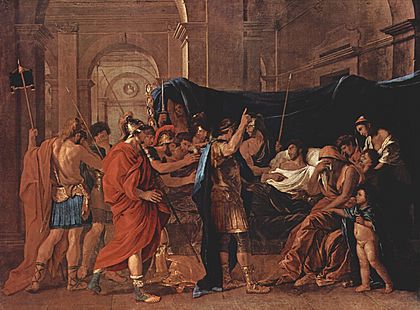
Germanicus then went to Egypt in January AD 19. He went there to help with a famine, as Egypt was vital for Rome's food supply. This trip upset Tiberius because it broke a rule set by Augustus: no senator could enter Egypt without the emperor's permission. Germanicus entered the province without asking first.
He returned to Syria by summer. There, he found that Piso had ignored or canceled his orders to cities and legions. Germanicus then formally ended his friendship with Piso. Germanicus became ill soon after and died on October 10 of that year. His death caused much talk, with some sources blaming Piso, possibly acting on Tiberius's orders. This was never proven. Piso later died while facing accusations. Some historians suggest Tiberius was involved because he was jealous of Germanicus's popularity.
Germanicus's sudden death greatly affected Tiberius's popularity in Rome. It also led to a climate of fear in the city.
After Germanicus's Death
When news of Germanicus's death reached Rome, people immediately began mourning, even before the Senate officially declared it. This showed how much the Roman people truly grieved for him. At his funeral, there were many speeches praising his good character, including one by Tiberius himself.
Many honors were given to Germanicus after his death. His name was added to a special religious song. His ivory statue led processions during the Circus Games. Knights in Rome named a section of theater seats after him.
Commemorative arches were built in his honor in Rome, on the Rhine frontier, and in Asia. Portraits of Germanicus and his father were placed in the Temple of Apollo in Rome.
On the day Germanicus died, his sister Livilla gave birth to twins. The older twin was named Germanicus but died young. In AD 37, Germanicus's only remaining son, Caligula, became emperor. He renamed the month of September "Germanicus" in honor of his father. Many Romans believed Germanicus was like their own Alexander the Great. They thought he would have achieved even more if he had become emperor.
Legacy
Germanicus is often shown in art because he was so important as a potential heir to the empire. He frequently appears in literature as the perfect Roman hero. His life and character have been shown in many artworks, including:
- Germanico in Germania (1732), an Italian opera.
- Death of Germanicus (1773–1774), a marble sculpture.
- Thusnelda im Triumphzug des Germanicus (1873), a painting.
- I, Claudius (1934), a historical fiction novel.
- The Caesars (1968), a British television series.
- I, Claudius (1976), a British television series.
- Barbarians (2020), a German television series.
Images for kids
-
Pleiades of the Leiden Aratea, an illustrated manuscript of Germanicus' Phaenomena dating to the 9th century.
See also
 In Spanish: Germánico para niños
In Spanish: Germánico para niños


